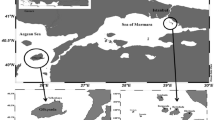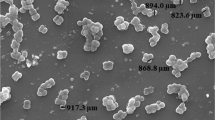Abstract
Crude extracts of 52 marine bacteria associated with sponges, which were collected from the sea near San Juan Island, Washington, USA, were screened using diatom attachment assays against Amphora sp., Nitzschia closterium, Sellaphora sp. and Stauroneis sp. to investigate their antidiatom activities. Among these samples, five expressed strong anti-adhesion effects on all four tested diatoms. There was no negative effect observed from those five active samples on the growth of Amphora sp. Those five active samples were prepared from respective isolates, which all belonged to the genus Bacillus based on 16S rRNA gene sequencing analysis. The results of present study indicate that Bacillus may play important roles for sponges’ chemical defence against biofouling of diatoms and that the metabolites of Bacillus may be a potential source of natural antifouling compounds.





Similar content being viewed by others
References
Anand TP, Bhat AW, Shouche YS, Roy U, Siddharth J, Sarma SP (2006) Antimicrobial activity of marine bacteria associated with sponges from the waters off the coast of South East India. Microbiol Res 161:252–262
Aumeier C, Menzel D (2012) Secretion in the diatoms. In: Vivanco JM, Baluska F (eds) Secretions and exudates in biological systems. Springer, Heidelberg, pp 221–250
Becker K (1996) Exopolysaccharide production and attachment strength of bacteria and diatoms on substrates with different surface tensions. Microb Ecol 32:23–33
Burgess JG, Boyd KG, Armstrong E, Jiang Z, Yan L, Berggren M, May U, Pisacane T, Granmo A, Adams DR (2003) The development of a marine natural product-based antifouling paint. Biofouling 19:197–205
Daniel GF, Chamberlain AHL, Jones EBG (1980) Ultrastructural observations on the marine fouling diatom Amphora. Helgolinder Meeresunters 34:123–149
Dash S, Jin CL, Lee OO, Xu Y, Qian PY (2009) Antibacterial and antilarval-settlement potential and metabolite profiles of novel sponge-associated marine bacteria. J Ind Microbiol Biotechnol 36:1047–1056
Dash S, Nogata Y, Zhou XJ, Zhang YF, Xu Y, Guo XR, Zhang XX, Qian PY (2011) Poly-ethers from Winogradskyella poriferorum: antifouling potential, time-course study of production and natural abundance. Bioresour Technol 102:7532–7537
de Brouwer JFC, Cooksey KE, Wigglesworth-Cooksey B, Staal MJ, Stal LJ, Avci R (2006) Time of flight-secondary ion mass spectrometry on isolated extracellular fractions and intact biofilms of three species of benthic diatoms. J Appl Microbiol 65:562–572
Dobretsov SV, Qian PY (2002) Effect of bacteria from surface of the green seaweed Ulva reticulata on marine micro- and macrofouling. Biofouling 18:276–287
Dobretsov S, Qian PY (2004) The role of epibotic bacteria from the surface of the soft coral Dendronephthya sp. in the inhibition of larval settlement. J Exp Mar Biol Ecol 299:35–50
Fusetani N (2004) Biofouling and antifouling. Nat Prod Rep 21:94–104
Guillard RRL, Ryther JH (1962) Studies of marine planktonic diatoms. I. Cyclotella nana Hustedt and Detonula confervacea Cleve. Can J Microbiol 8:229–239
Hentschel U, Schmid M, Wagner M, Fieseler L, Gernert C, Hacker J (2001) Isolation and phylogenetic analysis of bacteria with antimicrobial activities from the Mediterranean sponges Aplysina aerophoba and Aplysina cavernicola. FEMS Microbiol Ecol 35:305–312
Hilaluddin F, Leaw CP, Lim PT (2011) Morphological observation of common pennate diatoms (Bacillariophyceae) from Sarawak estuarine waters. Annu Microsc 11:12–23
Hoagland KD, Rosowski JR, Gretz MR, Roemer SC (1993) Diatom extracellular polymeric substances: function, fine structure, chemistry, and physiology. J Phycol 29:537–566
Kennedy J, Baker P, Piper C, Cotter PD, Walsh M, Mooij MJ, Bourke MB, Rea MC, O’Connor PM, Ross RP, Hill C, O’Gara F, Marchesi JR, Dobson ADW (2009) Isolation and analysis of bacteria with antimicrobial activities from the marine sponge Haliclona simulans collected from Irish waters. Mar Biotechnol 11:384–396
Kon-ya K, Shimidzu N, Otaki N, Yokoyama A, Adachi K, Miki W (1995) Inhibitory effect of bacterial ubiquinones on the settling of barnacle, Balanus Amphitrite. Experientia 51:153–155
Kristensen JB, Meyer RL, Laursen BS, Shipovskov S, Besenbacher F, Poulsen CH (2008) Antifouling enzymes and the biochemistry of marine settlement. Biotechnol Adv 26:471–481
Kumar V, Rao D, Thomas T, Kjelleberg S, Egan S (2010) Antidiatom and antibacterial activity of epiphytic bacteria isolated from Ulva lactuca in tropical waters. World J Microbiol Biotechnol 27(7):1543–1549
Lee OO, Qian PY (2003) The chemical control of bacterial epiosis and larval settlement of Hydroides elegans in the red sponge Mycale adherens. Biofouling 19(Suppl):171–180
Lee OO, Wong YH, Qian PY (2009) Inter- and intraspecific variations of bacterial communities associated with marine sponges from San Juan Island, Washington. Appl Environ Microbiol 75:3513–3521
Leflaive J, Ten-Hage L (2011a) Impairment of benthic diatom adhesion and photosynthetic activity by 2E, 4E-decadienal. Res Microbiol 162:982–989
Leflaive J, Ten-Hage L (2011b) Effects of 2E, 4E-decadienal on motility and aggregation of diatoms and on biofilm formation. Microb Ecol 61:363–373
Li Y, Liu CM, Yang JY, Gao YH, Li XS, Que GH, Lu JR (2011) Anti-biofouling properties of amphiphilic phosphorylcholine polymer films. Colloid Surf B Biointerfaces 85:125–130
Limna Mol VP, Raveendran TV, Parameswaran PS (2009) Antifouling activity exhibited by secondary metabolites of the marine sponge, Haliclona exigua (Kirkpatrick). Int Biodeter Biodegra 63:67–72
Lind JL, Heimann K, Miller EA, van Vliet C, Hoogenraad NJ, Wetherbee R (1997) Substratum adhesion and gliding in a diatom are mediated by extracellular proteoglycans. Planta 203:213–221
Ma YX, Liu PL, Yu SB, Li DT, Cao SM (2009) Inhibition of common fouling organisms in mariculture by epiphytic bacteria from the surfaces of seaweeds and invertebrates. Acta Ecol Sin 29:222–226
Mangano S, Michaud L, Caruso C, Brilli M, Bruni V, Fani R, Lo Giudice A (2009) Antagonistic interactions between psychrotrophic cultivable bacteria isolated from Antarctic sponges: a preliminary analysis. Res Microbiol 160:27–37
Mann DG, Evans KM, Chepurnov VA, Nagai S (2009) Morphology and formal description of Sellaphora bisexualis sp. nov. (Bacillariophyta). Fottea 9(2):199–209
Mizobuchi S, Abachi K, Miki W (1996) Antifouling polyhydroxysterols isolated from a Palauan octocoral of Sinularia sp. Fish Sci 62(1):98–100
Muscholl-Silberhorn A, Thiel V, Imhoff JF (2007) Abundance and bioactivity of cultured sponge-associated bacteria from the Mediterranean. Sea Microbial Ecol 55:94–106
Ortega-Morales B, Chan-Bacab M, Miranda-Tello E, Fardeau M, Carrero J, Stein T (2008) Antifouling activity of sessile bacilli derived from marine surfaces. J Ind Microbiol Biotechnol 35:9–15
Pabel CT, Vater J, Wilde C, Franke P, Hofemeister J, Adler B, Bringmann G, Hacker J, Hentschel U (2003) Antimicrobial activities and matrix-assisted laser desorption/ionization mass spectrometry of Bacillus isolates from the marine sponge Aplysina aerophoba. Mar Biotechnol 5:424–434
Qian PY, Xu Y, Fusetani N (2010) Natural products as antifouling compounds: recent progress and future perspectives. Biofouling 26(2):223–234
Santos OCS, Pontes PVML, Santos JFM, Muricy G, Giambiagi-deMarval M, Laport MS (2010) Isolation, characterization and phylogeny of sponge-associated bacteria with antimicrobial activities from Brazil. Res Microbiol 161:604–612
Silkina A, Bazes A, Mouget JL, Bourgougnon N (2012) Comparative efficiency of macroalgal extracts and booster biocides as antifouling agents to control growth of three diatom species. Mar Pollut Bull 64:2039–2046
Taylor MW, Radax R, Steger D, Wagner M (2007) Sponge-associated microorganisms: evolution, ecology, and biotechnological potential. Microbiol Mol Boil R 71:295–347
Thiel V, Imhoff JF (2003) Phylogenetic identification of bacteria with antimicrobial activities isolated from Mediterranean sponges. Biomol Eng 20:421–423
Thomas H, Jörn P (2009) Polyketide synthases of bacterial symbionts in sponges -evolution-based applications in natural products research. Phytochemistry 70:1841–1849
Wang G (2006) Diversity and biotechnological potential of the sponge-associated microbial consortia. J Ind Microbiol Biotechnol 33:545–551
Acknowledgments
This study was supported by the National Natural Science Foundation of China (No. 41076097, 41006097, 41106113, and 41271521), Key Project Chinese Ministry of Education (No. 211065), Natural Science Foundation of Jiangsu Province (No. BK2010322), Natural Science Foundation for College and University of Jiangsu Province (No. 11KJB170011), and SRF for ROCS, SEM for Xiaojian Zhou.
Author information
Authors and Affiliations
Corresponding author
Rights and permissions
About this article
Cite this article
Jin, C., Xin, X., Yu, S. et al. Antidiatom activity of marine bacteria associated with sponges from San Juan Island, Washington. World J Microbiol Biotechnol 30, 1325–1334 (2014). https://doi.org/10.1007/s11274-013-1557-0
Received:
Accepted:
Published:
Issue Date:
DOI: https://doi.org/10.1007/s11274-013-1557-0




